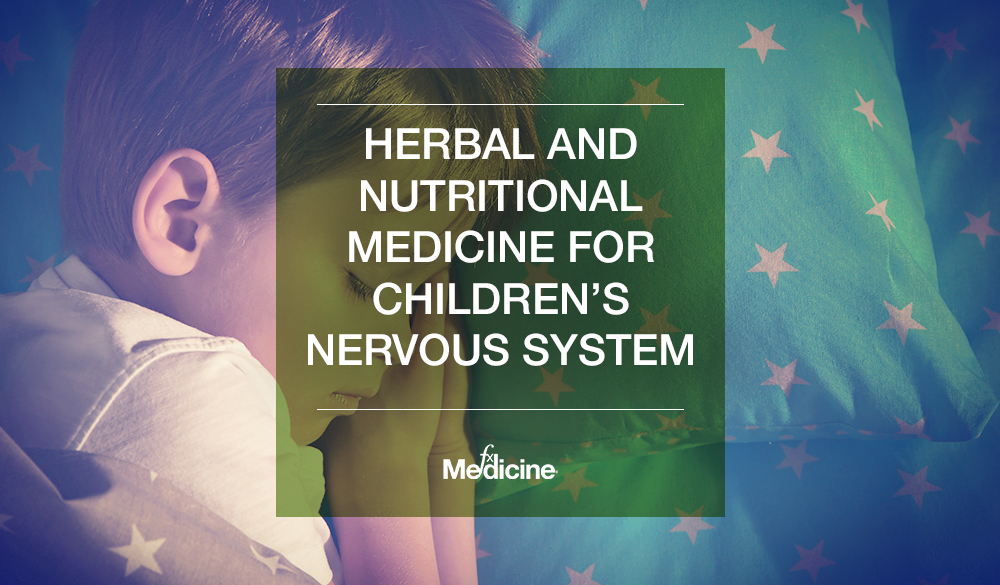Alinda Boyd ● 5 min read
Childhood encompasses a period of immense growth, not just physically, but emotionally and mentally as well. The developing nervous system is highly sensitive to external influences, and while some children adapt to these influences or stressors, other children do not adapt so easily. Accordingly, anxiety, irritability, hyperactivity, sleep disturbances and changes to mood may develop in children.
The Mental Health of Children and Adolescents report found that attention deficit hyperactivity disorder (ADHD) was the most common mental disorder experienced among Australian children followed by anxiety disorders, major depressive disorder and conduct disorder.[1] These conditions can range from mild through to severe and may have a significant impact on home, school and social life.
Herbal support
Herbal medicines, including valerian, lemon balm and passionflower have a long history of traditional use for supporting the nervous system in children, and have been used with efficacy for restlessness, anxiety, agitation, hyperactivity and insomnia.
The mechanism of action for these herbs are varied but include effects on the gammaaminobutyric acid (GABA) receptors. GABA is the major inhibitory neurotransmitter in the brain where it counteracts over excitation in the brain, acting like a “brake” during times of increased stress.[2] Low GABA levels or decreased GABA function in the brain have been associated with anxiety, depression and sleep disturbances.[2]
The traditional use of Valeriana officinalis (valerian) in western herbal medicine (WHM) for irritability, restlessness, nervousness and sleep disturbances extends over many centuries, while its use as a sedative extends back to ancient Greece over 2000 years ago.[3] Valerian may induce its relaxing effects by binding to GABAA receptors. Research has revealed that valerian acts on a specific GABAA receptor binding site which has an affinity for valerenic acid – one of the key active constituents of valerian.[4-6]
Melissa officinalis (lemon balm) has a history of use in WHM for sleep disturbances,anxiety and restlessness. Like valerian, the active constituents of lemon balm bind to GABAA receptors and increase the affinity of GABA to receptors.[3] Lemon balm may also have a beneficial effect on cognitive function.[3] Similar to valerian and lemon balm,Passiflora incarnata (passionflower) is used for anxiety, restlessness and sleep disturbances. Passionflower may also modulate the GABA system, with an affinity for both the GABAA and GABAB receptors.[7] Interestingly, a study analysing the amino acid content of various medicinal plants showed that passionflower contained the highest amount of GABA of the plants studied, although whether this would cross the blood-brain barrier and exert an effect is unknown.[8]
Use in children and clinical trials
In children, valerian, lemon balm and passionflower have been used successfully as monotherapies and in combination with other herbal preparations for restlessness, impulsiveness and sleep disturbances.
Specifically, a standardised valerian and lemon balm combination was found to be effective in both infants and school-aged children to improve restlessness and sleep disturbances.[9]
Another study showed that a valerian and lemon balm combination improved restlessness, concentration difficulties, impulsiveness, social behaviour and sleep difficulties in primary school children suffering from hyperactivity and concentration difficulties but not meeting ADHD criteria.[10]
In children with ADHD, passionflower demonstrated significant clinical benefits comparable to low-dose methylphenidate (Ritalin) in a small, randomised trial.[11]
Safety in children
The gentle nature and non-addictive properties of herbal medicines make them an attractive option for the treatment of childhood nervous system disorders.[12] Clinical trial safety echoes the traditional safety of these herbal medicines in children, with clinical trials utilising valerian, lemon balm and passionflower showing high levels of safety and tolerability, with very few adverse effects.[9-11]
Nutritional support
Nutritional interventions for improving memory and learning in children are increasingly being sought out by researchers and health care practitioners alike. Both choline and inositol may provide support for children’s cognitive function due to their role in memory and brain function.
Choline is an essential vitamin-like compound found in the form of phosphatidylcholine in membranes, with eggs, meat, seafood, legumes, and wheat germ providing good dietary sources. It is made endogenously in small amounts, however these amounts do not meet physiological requirements.[13] Among choline’s roles in the body is as a precursor to acetylcholine, a neurotransmitter synthesised by cholinergic neurons, which is essential for memory, circadian rhythm, muscle control and other brain and nervous system functions.[14]
Acetylcholine synthesis is likely determined by choline availability and as such, dietary intake of choline may directly impact cholinergic stimulation[15] and have follow on effects on memory, mood and brain function.
Inositol is an important component of the intracellular phosphatidyl inositol second messenger system which interacts with several neurotransmitters including serotonin and cholinergic receptors, which in turn affect mood, learning and memory.[16]
Animal studies have shown that high choline intake during gestation and the early postnatal period improves cognitive function throughout life, prevents memory decline, and protects the brain from neuropathological changes.[17] A recent review surmised that adequate choline intake throughout all stages of life is an important determinant of brain development,cognitive performance and resistance to cognitive decline and neurodegeneration.[17]
Decreased brain levels of inositol have been reported in patients with depression and anxiety, and as such, inositol has been used in conditions such as anxiety, depression,panic disorders and obsessive-compulsive disorders.[16]
Although clinical trials are needed in this area, both choline and inositol may provide important nutrients for cholinergic receptor function and acetylcholine synthesis, which in turn may help to support memory, mood and brain function throughout childhood.
References
- Lawrence D, Johnson S, Hafekost J, et al. The mental health of children and adolescents. Report on the second Australian Child and Adolescent Survey of Mental Health and Wellbeing, 2015. Canberra: Department of Health. [Abstract]
- Gamma-aminobutyric acid (GABA). Altern Med Rev 2007;12(3):274-279. [Abstract]
- Braun L, Cohen M. Herbs and natural supplements: an evidence-based guide, 3rd ed, 2010. Sydney: Churchill Livingstone Elsevier. [Abstract]
- Becker A, Felgentreff F, Schröder H, et al. The anxiolytic effects of a valerian extract is based on valerenic acid. BMC Complement Altern Med 2014;14:267. [Full Text]
- Benke D, Barberis A, Kopp S, et al. GABA A receptors as in vivo substrate for the anxiolytic action of valerenic acid, a major constituent of valerian root extracts Neuropharmacology 2009;56(1):174-181. [Abstract]
- Trauner G, Khom S, Baburin I, et al. Modulation of GABAA receptors by valerian extracts is related to the content of valerenic acid. Planta Med 2008;74(1):19-24. [Abstract]
- Appel K, Rose T, Fiebich B, et al. Modulation of the Y-aminobutyric acid (GABA) system by Passiflora incarnata L. Phytother Res 2011 Jun;25(6):838-43. [Abstract]
- Carratù B, Boniglia C, Giammarioli S, et al. Free amino acids in botanicals and botanical preparations. J Food Sci 2008;73(5):C323-328.Müller SF, Klement S. A combination of valerian and lemon balm is effective in the treatment of restlessness and dyssomnia in children. Phytomedicine 2006; 13(6): 383-387. [Abstract]
- Gromball J, Beschorner F, Wantzen C, et al. Hyperactivity, concentration difficulties and impulsiveness improve during seven weeks’ treatment with valerian root and lemon balm extracts in primary school children. Phytomedicine 2014;21(8-9):1098-1103. [Abstract]
- Akhondzadeh S, Mohammadi MR, Momeni F. Passiflora incarnata in the treatment of attention-deficit hyperactivity disorder in children and adolescents. Therapy 2005;2(4):609-614. [Abstract]
- Santich R, Bone K. Healthy children: optimising children’s health with herbs, 2008. Warwick: Phytotherapy Press. [Source]
- National Health and Medical Research Council. Choline. Nutrient Reference Values. Viewed 6 Apr 2019, [Source]
- Choline. Micronutrient Information Centre, Linus Pauling Institute 2015. Viewed 6 Apr 2019, [Source]
- Sanders LM, Zeisel SH. Choline: dietary requirements and role in brain development. Nutr Today 2007;42(4):181-186. [Abstract]
- Inositol. Natural Medicines comprehensive database 2019. Viewed 7 Apr 2019, [Source]
- Blusztajn JK, Slack BE, Mellott TJ. Neuroprotective actions of dietary choline. Nutrients 2017;9(8). pii: E815. [Abstract]
DISCLAIMER:
The information provided on FX Medicine is for educational and informational purposes only. The information provided on this site is not, nor is it intended to be, a substitute for professional advice or care. Please seek the advice of a qualified health care professional in the event something you have read here raises questions or concerns regarding your health.



